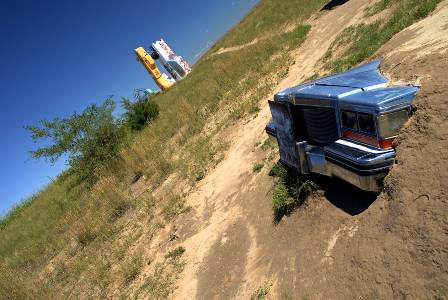Corn, sunflowers, and grass aren’t the only things sprouting out of the ground in Nebraska. So are cars. Dozens of them, some standing on their noses, half-submerged in the soil of the fertile plains, others lying on their bellies, partially covered by dirt. It’s one of the strangest displays on earth, meant to pay homage to a much older, and even more puzzling monument.

Unlike the mystery of England’s Stonehenge, modern man knows exactly how Nebraska’s version came to be. The only surprise at Carhenge, is just how captivating the entire display becomes, after you’ve walked around it for a while, examining sedans, station wagons, gas guzzlers and compact clunkers from every possible angle.

Much like Stonehenge, Carhenge is a circular arrangement of pillars, some capped off and tied together, others lying outside the central core. Of course in the original, stones were used, while here, Detroit’s finest were granted immortality. And unlike the original, which dates back 2,000 years or more before Christ, the Great Plains version has only been around for a couple of decades.
Back in 1982, Herman Reinders, the father of Carhenge creator Jim Reinders passed away. As Jim and other family members gathered to remember their loved one, they realized the need for some sort of memorial. The family agreed to regroup in five years, and build their tribute.
Once those years passed, about 35 members of the family fulfilled their promise, and gathered on Herman’s’ old farm, just outside Alliance, Nebraska. The team went to work, digging holes and burying cars, and by the summer solstice of 1987, the work was complete.
In the weeks and months that followed, Carhenge nearly became a short-lived tribute. Alliance’s city council ordered the creation be torn down. But Carhenge was growing on the local population, and a group formed to fight for its preservation. That group, Friends of Carhenge, now owns and maintains it.

The 38 automobiles used to create Carhenge are all currently spray-painted grey. Any cars that are precariously placed, have been welded into position. The entire assemblage is extremely solid — it’s not going anywhere.

The thing that intrigued me most about Carhenge as a photographer, is the number of different ways to look at it.

Where else, except an auto repair shop, do you get a chance to walk underneath cars, look up at them, and examine them from every possible angle?

I also found it remarkable, that so many details still survive on the cars. From those hood-mounted turn signals to antennas, windshield wipers…

… and even name plates. Of course, some have been ripped off and taken away as souvenirs, but many still survive. There are so many details to observe and appreciate here, I could have taken an endless number of photographs.

Carhenge isn’t just about replicating Stonehenge, though. In the surrounding field, outside of the original circle of cars and trucks…

… there are several other car-themed art projects. This one is called the “Fourd Seasons”. It represents the four stages of Nebraska’s wheat fields: green is for spring, yellow (the tall, 2-car stack) is mature, pink is after harvest, and white (the leaning car) is winter.

It takes a minute of pondering to appreciate the Carnastoga. It’s a wagon (appropriately represented by a station wagon) with big spoke wheels, pulled by two “horses” represented by engines, which are positioned where horses belong — in front of the wagon.

Other cars are scattered around. For some, their artistic purpose is not immediately clear. They aren’t painted grey, so I assume they’re not an outlying part of Carhenge itself.

Look closely at a couple of the submerged cars, and you’ll notice signs declaring them to be “carsules” — that’s a time capsule, made from a car.

Other art projects are simply made from parts of a car, like this whirligig…

… and the impressive “Spawning Salmon” by Canadian artist Geoff Sandhurst.

While the art is nice, I ultimately found myself drawn back to the cars. I probably spent an hour here, running back and forth snapping pictures, while swearing to myself, “okay, this is the last one.”

Continuing up Route 87, it looks like someone else has tried to get in on the act of creating kitschy roadside art. The open-air rest area just doesn’t have the same appeal as Carhenge, though.

A little further north, I passed another beautiful sunflower field, with blooms stretching as far as the eye could see.
Note: This trip was first published in 2008.







No comments